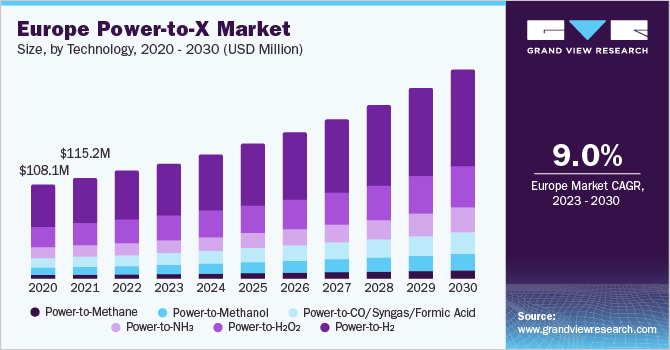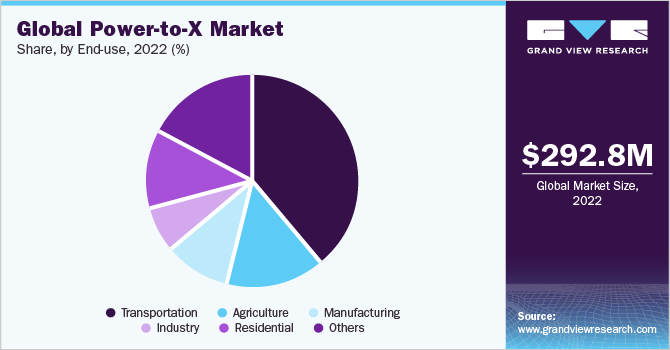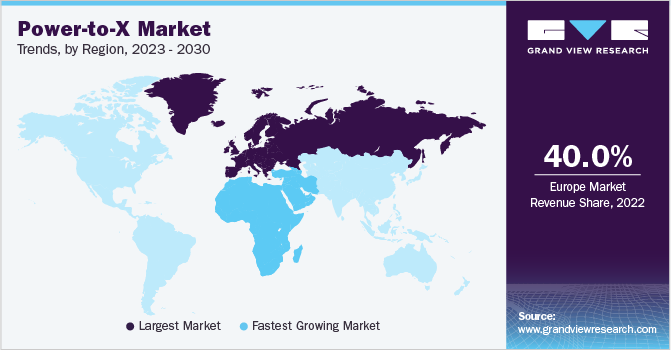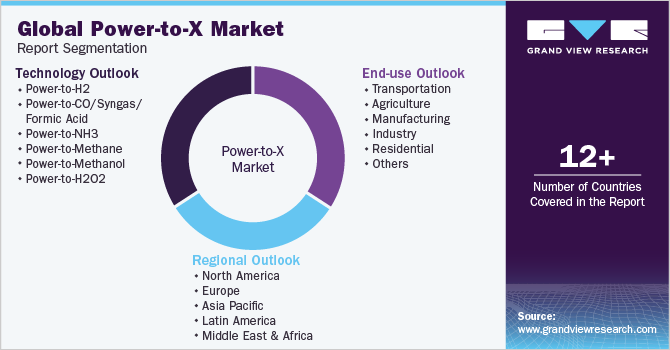
Power-to-X Market Size, Share & Trends Analysis Report By Technology (Power-to-H2, Power-to-Methanol), By End-use (Agriculture, Manufacturing), By Region, And Segment Forecasts, 2023 - 2030
- Report ID: GVR-4-68040-101-1
- Number of Pages: 100
- Format: Electronic (PDF)
- Historical Range: 2017 - 2021
- Industry:Technology
Report Overview
The globalpower-to-X market sizewas estimated atUSD 292.8 million in 2022and is expected to grow at a compound annual growth rate (CAGR) of 10.6% from 2023 to 2030. The primary driver behind the market growth is the urgency to mitigate climate change by reducing greenhouse gas (GHG) emissions. Power-to-X (P2X) technologies offer a pathway to decarbonize sectors that are challenging to electrify directly, such as heavy transportation and industrial processes. Climate change poses a significant threat to the planet, necessitating urgent action to reduce GHG emissions. The market plays a crucial role in addressing this challenge by enabling the decarbonization of sectors that heavily rely on fossil fuels, such as transportation and industrial processes.

These sectors account for significant global carbon emissions and pose a challenge to electrify using conventional means. Power-to-X technologies offer innovative solutions to decarbonize these challenging sectors, encompassing processes like power-to-hydrogen, power-to-ammonia, power-to-methane, and power-to-liquids. These technologies involve using renewable or low-carbon electricity to produce hydrogen,ammonia, methane, or synthetic fuels, which can then be used as clean energy carriers or feedstocks in transportation and industrial applications. Governments are engaging in international collaboration and agreements to promote the adoption of power-to-X technologies, which include partnerships and knowledge-sharing platforms to exchange best practices, research findings, and policy approaches.
International agreements, such as the Paris Agreement, set global targets for reducing GHG emissions, further driving the adoption and implementation of power-to-X solutions worldwide. Regulatory bodies are enacting policies and regulations that promote the use of low-carbon fuels and chemicals, often derived from power-to-X processes. These regulations may include blending mandates for low-carbon fuels in transportation sectors, setting emission reduction targets, or incentivizing the adoption of cleaner alternatives in industrial applications. Such regulations create a market demand for power-to-X-derived products and drive the growth of the industry.
The continuous R&D efforts in P2X technologies drive significant advancements in electrolysis technologies, catalyst development, system integration, and process optimization. These innovations are expected to improve the efficiency, scalability, and cost-effectiveness of power-to-X processes. The ongoing collaboration, knowledge sharing, and technological advancements contribute to accelerating the industry growth, supporting the global transition to a low-carbon and sustainable future.
Technology Insights
The power-to-H2 segment represented the highest revenue share of over 44.9% in 2022 and is anticipated to remain dominant throughout the forecast period. Hydrogen produced through power-to-H2 can be used as a clean fuel for various applications, including transportation and industrial processes. By substituting fossil fuels with hydrogen, emissions of greenhouse gases can be significantly reduced, leading to the decarbonization of sectors that are difficult to electrify directly, such as heavy-duty transportation, aviation, and industrial heating.
The power-to-methanol segment is estimated to grow significantly over the forecast period. The methanol produced through power-to-X processes offers a pathway for decarbonizing the transportation sector. Utilizing renewable electricity to produce methanol, carbon emissions associated with conventional methanol production from fossil fuels can be significantly reduced or eliminated. In addition,methanolcan serve as a convenient carrier of hydrogen, allowing for the storage and transportation of hydrogen without the challenges associated with handling and storing pure hydrogen.
End-use Insights
The transportation segment held the largest revenue share of over 38.5% in 2022. Power-to-X provides a diversified energy transition pathway in the transportation sector. While battery electric vehicles (EVs) are gaining popularity, power-to-X technologies offer an alternative for applications where batteries may not be the most suitable solution due to factors such as energy density, weight, or recharging time. By providing multiple options, power-to-X contributes to a balanced and comprehensive approach to decarbonizing transportation. The residential segment is predicted to foresee significant growth in the forecast years.

This segment growth is attributed to the high importance of data governance in the sector. The power-to-X displays a business' data assets and locations, while data governance identifies data owners and consumers. It aids users in managing their data. Therefore, many data users know where to turn whenever a data query arises. Increasing data volumes have initiated power-to-X to become an essential tool in the portfolio of data governance capabilities. The enterprise framework offered by data governance also promotes teamwork and collaboration among data users in various departments to synthesize all the technical and commercial information of an organization's data assets.
Regional Insights
2022年欧洲主导市场、会计for over 40% share of the global revenue. Supportive policies and regulations in Europe are crucial in driving the adoption of power-to-X technologies. For instance, the European Union's Clean Energy Package includes provisions specifically targeting power-to-X deployment and support mechanisms for renewable hydrogen and synthetic fuels. These policies create a favorable market environment, incentivize investment, and stimulate innovation in European power-to-X technologies. Middle East & Africa is anticipated to register the highest CAGR from 2023 to 2030. The potential for a hydrogen economy is also gaining traction in the MEA region.

Embracing power-to-X technologies can pave the way for developing a hydrogen economy, creating economic opportunities, fostering regional cooperation, and contributing to sustainable development goals. By November 2022, the UAE had six hydrogen projects under development with an investment worth USD 1.66 billion. With these projects, the UAE will be able to supply 25 percent of the global low-carbon hydrogen by 2030. In January 2021, the country also formed the Abu Dhabi Hydrogen Alliance, comprising ADQ, Mubadala Investment Company, ADNOC, and the country’s Ministry of Energy and Infrastructure. The UAE has been actively investing in renewable energy projects and exploring the potential of power-to-X technologies in recent years.
Key Companies &Market Share Insights
Key companies focus on product R&D to strengthen their market position. For instance, in December 2022, FlagshipONE, Europe's largest green e-methanol project, received the final investment decision from Orsted A/S. The FlagshipONE plant will be Orsted's first commercial power-to-X facility and a critical step towards Orsted's ambition to lead in green fuels and renewable hydrogen. Companies in the industry strategically focus on acquiring early-stage power-to-X suppliers offering a broader range of products and services. For instance, in March 2023, Lhyfe, a green hydrogen specialist based in France, acquired a 49% stake in Flexens Oy Ab, a Finnish developer of power-to-X projects. The collaboration between the two companies aims to leverage their expertise and commercial pipelines to expedite ongoing projects and explore fresh opportunities in Northern Europe, with a specific focus on significant offshore endeavors. Some prominent players in the global power-to-X market include:
Air Liquide
Linde
Siemens Energy
Mitsubishi Hitachi Power Systems
HPEM2GAS
Thyssenkrupp
IRENA
Neles
Neles (Valmet Oyj)
Weidmüller
Copenhagen Infrastructure Partners
Alfa Laval
Power-to-X Market Report Scope
Report Attribute |
Details |
Market size value in 2023 |
USD 318.0 million |
Revenue forecast in 2030 |
6美元45.3 million |
Growth rate |
CAGR of 10.6% from 2023 to 2030 |
Base year for estimation |
2022 |
Historical data |
2017 - 2021 |
Forecast period |
2023 - 2030 |
Quantitative units |
Revenue in USD million, and CAGR from 2023 to 2030 |
Report coverage |
Revenue forecast, company ranking, competitive landscape, growth factors, and trends |
Segments covered |
Technology, end-use, region |
Regional scope |
北美;欧洲;亚太地区;拉丁美洲; MEA |
Country scope |
U.S.; Canada; UK; Germany; France; China; Japan; India; South Korea; Australia; Brazil; Mexico; UAE; KSA; South Africa |
Key companies profiled |
Air Liquide; Linde; Mitsubishi Hitachi Power Systems; HPEM2GAS; Thyssenkrupp; IRENA; Neles; Weidmüller; Copenhagen Infrastructure Partners; Alfa Laval |
Customization scope |
Free report customization (equivalent up to 8 analysts working days) with purchase. Addition or alteration to country, regional & segment scope. |
Pricing and purchase options |
Avail customized purchase options to meet your exact research needs.Explore purchase options |
Global Power-to-X Market Report Segmentation
This report forecasts revenue growth at global, regional, and country levels and provides an analysis of the latest industry trends in each of the sub-segments from 2017 to 2030. For this study, Grand View Research has segmented the global power-to-X market report based on technology, end-use, and region:

Technology Outlook (Revenue, USD Million, 2017 - 2030)
Power-to-H2
Power-to-CO/Syngas/Formic Acid
Power-to-NH3
Power-to-Methane
Power-to-Methanol
Power-to-H2O2
End-use Outlook (Revenue, USD Million, 2017 - 2030)
Transportation
Agriculture
Manufacturing
Industry
Residential
Others
Regional Outlook (Revenue, USD Million, 2017 - 2030)
North America
U.S.
Canada
Europe
UK
Germany
France
Asia Pacific
China
Japan
India
South Korea
Australia
拉丁美洲
Brazil
Mexico
Middle East and Africa (MEA)
KSA
UAE
South Africa
Frequently Asked Questions About This Report
b.The global power-to-X market size was estimated at USD 292.8 million in 2022 and is expected to reach USD 318.0 million in 2023.
b.The global power-to-X market is expected to grow at a compound annual growth rate of 10.6% from 2023 to 2030 to reach USD 645.3 million by 2030.
b.Europe accounted for the highest value share in 2022 owing to supportive government policies and regulations in Europe are crucial in driving the adoption of power-to-x technologies.
b.一些关键的players operating in the automation testing market include Air Liquide; Linde; Mitsubishi Hitachi Power Systems; HPEM2GAS; Thyssenkrupp; IRENA; Neles; Weidmüller; Copenhagen Infrastructure Partners; Alfa Laval and others.
b.Key factors that are driving the power-to-X market growth include the urgent need to mitigate climate change by reducing greenhouse gas emissions.





